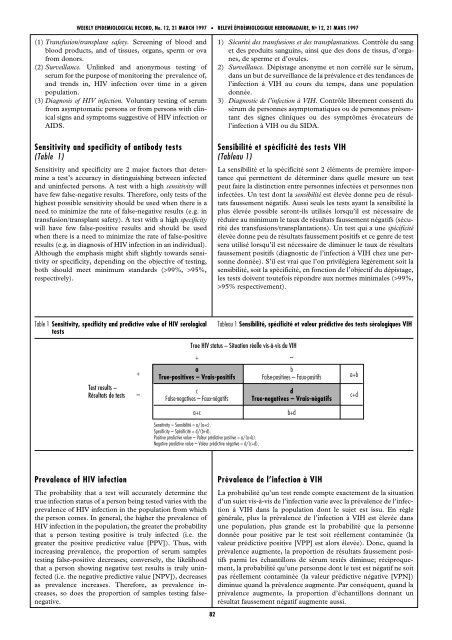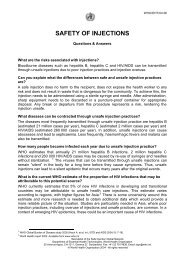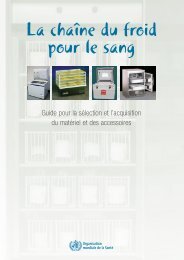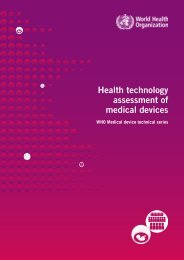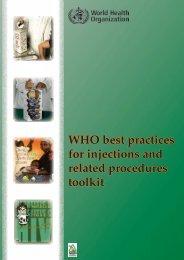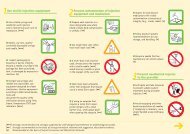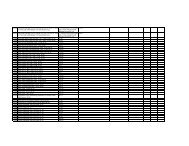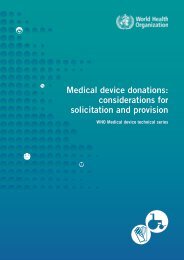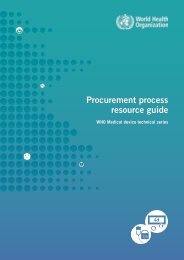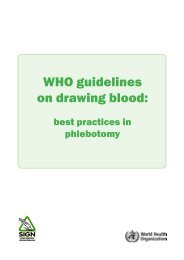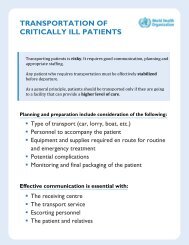<strong>WEEKLY</strong> <strong>EPIDEMIOLOGICAL</strong> <strong>RECORD</strong>, <strong>No</strong>. <strong>12</strong>, <strong>21</strong> <strong>MARCH</strong> <strong>1997</strong>(1) Transfusion/transplant safety. Screening of blood andblood products, and of tissues, organs, sperm or ovafrom donors.(2) Surveillance. Unlinked and anonymous testing ofserum for the purpose of monitoring the prevalence of,and trends in, HIV infection over time in a givenpopulation.(3) Diagnosis of HIV infection. Voluntary testing of serumfrom asymptomatic persons or from persons with clinicalsigns and symptoms suggestive of HIV infection orAIDS.Sensitivity and specificity of antibody tests(Table 1)Sensitivity and specificity are 2 major factors that determinea test’s accuracy in distinguishing between infectedand uninfected persons. A test with a high sensitivity willhave few false-negative results. Therefore, only tests of thehighest possible sensitivity should be used when there is aneed to minimize the rate of false-negative results (e.g. intransfusion/transplant safety). A test with a high specificitywill have few false-positive results and should be usedwhen there is a need to minimize the rate of false-positiveresults (e.g. in diagnosis of HIV infection in an individual).Although the emphasis might shift slightly towards sensitivityor specificity, depending on the objective of testing,both should meet minimum standards (>99%, >95%,respectively).• RELEVÉ ÉPIDÉMIOLOGIQUE HEBDOMADAIRE, N o <strong>12</strong>, <strong>21</strong> MARS <strong>1997</strong>1) Sécurité des transfusions et des transplantations. Contrôle du sanget des produits sanguins, ainsi que des dons de tissus, d’organes,de sperme et d’ovules.2) Surveillance. Dépistage anonyme et non corrélé sur le sérum,dans un but de surveillance de la prévalence et des tendances del’infection à VIH au cours du temps, dans une populationdonnée.3) Diagnostic de l’infection à VIH. Contrôle librement consenti dusérum de personnes asymptomatiques ou de personnes présentantdes signes cliniques ou des symptômes évocateurs del’infection à VIH ou du SIDA.Sensibilité et spécificité des tests VIH(Tableau 1)La sensibilité et la spécificité sont 2 éléments de première importancequi permettent de déterminer dans quelle mesure un testpeut faire la distinction entre personnes infectées et personnes noninfectées. Un test dont la sensibilité est élevée donne peu de résultatsfaussement négatifs. Aussi seuls les tests ayant la sensibilité laplus élevée possible seront-ils utilisés lorsqu’il est nécessaire deréduire au minimum le taux de résultats faussement négatifs (sécuritédes transfusions/transplantations). Un test qui a une spécificitéélevée donne peu de résultats faussement positifs et ce genre de testsera utilisé lorsqu’il est nécessaire de diminuer le taux de résultatsfaussement positifs (diagnostic de l’infection à VIH chez une personnedonnée). S’il est vrai que l’on privilégiera légèrement soit lasensibilité, soit la spécificité, en fonction de l’objectif du dépistage,les tests doivent toutefois répondre aux normes minimales (>99%,>95% respectivement).Table 1 Sensitivity, specificity and predictive value of HIV serologicaltestsTableau 1 Sensibilité, spécificité et valeur prédictive des tests sérologiques VIHTrue HIV status – Situation réelle vis-à-vis du VIH+ –abTrue-positives – Vrais-positifs False-positives – Faux-positifsTest results –Résultats de tests+–cdFalse-negatives – Faux-négatifs True-negatives – Vrais-négatifsa+bc+da+cb+dSensitivity – Sensibilité = a/(a+c).Specificity – Spécificité = d/(b+d).Positive predictive value – Valeur prédictive positive = a/(a+b).Negative predictive value – Valeur prédictive négative = d/(c+d).Prevalence of HIV infectionThe probability that a test will accurately determine thetrue infection status of a person being tested varies with theprevalence of HIV infection in the population from whichthe person comes. In general, the higher the prevalence ofHIV infection in the population, the greater the probabilitythat a person testing positive is truly infected (i.e. thegreater the positive predictive value [PPV]). Thus, withincreasing prevalence, the proportion of serum samplestesting false-positive decreases; conversely, the likelihoodthat a person showing negative test results is truly uninfected(i.e. the negative predictive value [NPV]), decreasesas prevalence increases. Therefore, as prevalence increases,so does the proportion of samples testing falsenegative.Prévalence de l’infection à VIHLa probabilité qu’un test rende compte exactement de la situationd’un sujet vis-à-vis de l’infection varie avec la prévalence de l’infectionà VIH dans la population dont le sujet est issu. En règlegénérale, plus la prévalence de l’infection à VIH est élevée dansune population, plus grande est la probabilité que la personnedonnée pour positive par le test soit réellement contaminée (lavaleur prédictive positive [VPP] est alors élevée). Donc, quand laprévalence augmente, la proportion de résultats faussement positifsparmi les échantillons de sérum testés diminue; réciproquement,la probabilité qu’une personne dont le test est négatif ne soitpas réellement contaminée (la valeur prédictive négative [VPN])diminue quand la prévalence augmente. Par conséquent, quand laprévalence augmente, la proportion d’échantillons donnant unrésultat faussement négatif augmente aussi.82
Quality assurance<strong>WEEKLY</strong> <strong>EPIDEMIOLOGICAL</strong> <strong>RECORD</strong>, <strong>No</strong>. <strong>12</strong>, <strong>21</strong> <strong>MARCH</strong> <strong>1997</strong>All laboratories carrying out HIV tests should have a qualityassurance programme. It is most important that qualitycontrol procedures be stringently complied with so as tomaximize the accuracy of the laboratory results. Proceduresfor detecting both technical and clerical errors mustbe included in all protocols. For example, procedures thatguarantee the correct identification of initially reactiveunits of donated blood, which must be discarded, areessential to the maintenance of a safe blood supply. It isrecommended that laboratories submit to an external qualityassessment at least once a year.• RELEVÉ ÉPIDÉMIOLOGIQUE HEBDOMADAIRE, N o <strong>12</strong>, <strong>21</strong> MARS <strong>1997</strong>Assurance de la qualitéTout laboratoire pratiquant des tests de recherche des anticorpsanti-VIH doit avoir un programme d’assurance de la qualité. Il estcapital de respecter strictement les dispositions du contrôle de laqualité, afin de garantir au maximum l’exactitude des résultats delaboratoire. Il faut inclure dans tous les protocoles des instructionspour la détection d’erreurs techniques ou d’écriture. Par exemple,les instructions garantissant l’identification correcte d’unités desang donné initialement positives, dont il faut alors se débarrasser,sont essentielles pour un approvisionnement en sang non contaminé.Il est recommandé que les laboratoires se soumettent à uneévaluation externe de la qualité au moins une fois par an.Strategies for HIV antibody testingSeveral studies and field experiences have shown thatminor modifications to the 3 testing strategies recommendedin 1992 are needed. Both the selection of and theorder in which the assays are used are of the utmostimportance for the final outcome of the strategy. As HIVantibody assays have become more sensitive over the years,the probability of a false-positive reaction in 2 assays basedon a different principle is not negligible. Therefore, if testcombinations are not carefully selected, individuals may bewrongly diagnosed as HIV seropositive. Conversely, themore specific assays are presently slightly less sensitive ascompared to the average HIV antibody test, which mayresult in a false-negative diagnosis. These observationscause concern with regard to strategies II and III of the1992 recommendations. The choice of the most appropriateHIV tests also depends on the HIV variants present in aparticular geographical region (e.g. HIV-1 group O).Therefore, test combinations should always be evaluatedin the context in which they will be used beforewide-scale implementation.Studies have shown that combinations of ELISA and/or simple/rapid assays such as dot immunoassays and agglutinationtests can provide results as reliable as, and insome instances more reliable than, the ELISA/Westernblot (WB) combination, and at a much lower cost. Atpresent, a number of countries use a selection of differentHIV screening assays in a particular order, to minimize thenumber of costly confirmatory assays. 1 Confirmatory assaysshould only be used to resolve indeterminate resultsfor diagnostic purposes. UNAIDS and WHO thereforerecommend that countries consider testing strategies forHIV antibody detection which use ELISA and/or simple/rapid assays rather than ELISA/WB.Stratégies pour la recherche des anticorps anti-VIHPlusieurs études et l’expérience acquise sur le terrain montrentqu’il est nécessaire d’apporter quelques changements aux 3 stratégiesrecommandées en 1992. Tant le choix des tests que l’ordredans lequel ils doivent être utilisés sont d’une importance capitalepour l’issue de la stratégie. Dans la mesure où les tests de recherchedes anticorps VIH ont gagné en sensibilité au fil des années, laprobabilité d’un résultat faussement positif à 2 tests fondés sur unprincipe différent n’est pas négligeable. En conséquence, si lescombinaisons de tests ne sont pas judicieusement choisies, undiagnostic de séroposivité VIH risque d’être posé à tort chezcertaines personnes. Inversement, les tests plus spécifiques sontpour le moment légèrement moins sensibles que le test VIHmoyen, ce qui peut déboucher sur un diagnostic faussement négatif.Ces observations posent problème par rapport aux stratégies IIet III exposées dans les recommandations de 1992. Le choix destests VIH les plus appropriés dépend également des variants deVIH présents dans une région particulière (par exemple, VIH-1groupe O). Il convient donc de toujours déterminer les combinaisonsde tests compte tenu du contexte dans lequel ellesseront utilisées avant la mise en œuvre à grande échelle.Des études ont montré que la combinaison d’un ELISA et/oud’un test simple/rapide tel que l’épreuve immuno-enzymatique etles épreuves d’agglutination peuvent donner des résultats aussifiables, et dans certains cas plus fiables, que la combinaisonELISA/Western blot, et pour un coût bien moindre. Actuellement,un certain nombre de pays utilisent un choix de tests VIH différentsdans un ordre déterminé, pour réduire l’utilisation de tests deconfirmation 1 onéreux. Les tests de confirmation ne doivent êtreutilisés que dans le cas d’un résultat incertain pour poser undiagnostic. L’ONUSIDA et l’OMS recommandent donc aux paysd’envisager l’adoption de stratégies de dépistage fondées sur l’utilisationdu test ELISA et/ou de tests simples/rapides, plutôt que surl’ELISA/Western blot.RecommendationsUNAIDS and WHO recommend 3 testing strategies tomaximize accuracy while minimizing cost. Which strategyis most appropriate will depend on the objectives of the testand the prevalence of HIV in the sample population, asshown in Table 2 and Fig. 1.RecommandationsL’ONUSIDA et l’OMS recommandent 3 stratégies de dépistageafin d’obtenir une exactitude maximale pour un coût minimal. Lechoix de la stratégie la plus appropriée dépend de l’objectif dudépistage et de la prévalence du VIH dans la population, commeindiqué au Tableau 2 et à la Fig. 1.1Western blot or similar assays based on recombinant proteins and/orsynthetic peptides capable of detecting antibodies to specific HIV-1 and/orHIV-2 proteins.1Le Western blot ou des tests similaires utilisant des protéines recombinantes et/ou despeptides synthétiques capables de détecter les anticorps dirigés contre des protéinesspécifiques du VIH-1 ou du VIH-2.83


